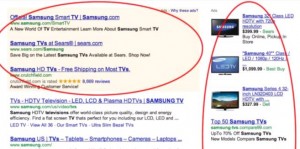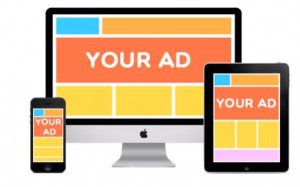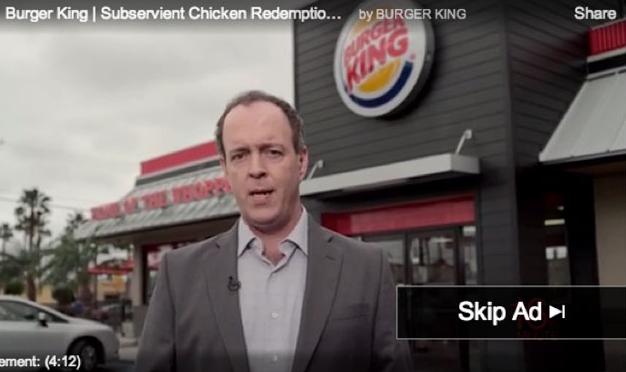When Google launched its AdWords in 2000, text ads were only shown above and to the side of Google’s search bar results. While the ads on the side have been taken away, those text ads are still accessible. There are now several different types of ads available for companies of all industries and sizes.
Here’s a brief introduction to the many options Google ads has to offer.
Search Ads
Search advertisements are the most familiar to consumers. They are the ads that can be seen at the top of the Google search results page based on a user’s search query. These text advertisements can also be seen in Gmail or Google Maps when someone searches particular keywords.

Search ads can also appear on other search sites that are part of the Google Display Network. What is the Google Display network or GDN? Other websites have partnered with Google to show AdWords ads, for example AOL. So your digital ads might appear alongside search results on other related search pages.
There are numerous ways to target these Google ads based on keywords (what words people are searching for), such as time of day, locality, device, and so on. There are also a range of Google ad extensions that can include locations, website links, phone calls, assessments, and more.
Product Listing Ads (Also known as PLAs) are a Google ad format that include a picture, title, fee, your company name, etc. There needs to be an information feed in place to a Google Merchant Center account, which is then linked to Adwords. Product listing ads are usually used for e-commerce websites, but there are choices for “available near me” which combines a local store’s inventory and the location of the individual looking for that service or product.

Display Ads
Every person is familiar with banner ads on news websites and blogs, but did you know that many of the digital banner ads you see are part of Google AdWords? And not just the digital banner ads, but text ads in addition to rich media ads as well. Ads on the GDN reaches users across all types of platforms on over 2 million websites—from small niche blogs sites to websites with a ton of daily traffic.
Text Ads on the GDN (Google Display Network) give companies access to the largest pool of text inventory obtainable. These are the text ads you see in Gmail and several other sites.
Image Ads are the huge graphic ads across the top, side, or bottom of a website. These are ever present on news and entertainment websites, media, and all over online. Many individuals refer to them as “banner ads.”
Rich Media Ads allow users to intermingle with an image or video. Interactions in these digital ads can range from hovering the mouse over the Google ad to expand the unit, to playing a video, or clicking for content.
One remarkable feature the Google Display Network offers is remarketing (some call it retarget marketing). Remarketing shows digital ads to users who have visited your company’s website before. When web users leave your website without buying, remarketing helps you reconnect with them by showing relevant digital ads as they surf the web, even as they use a mobile device or as they search Google. Remarketing campaigns can be extremely successful at driving sales activity, increasing signups, or marketing brand awareness. The price is very reasonable as well.

YouTube Ads
YouTube marketing is technically considered part of the Google display network, but there are many different types of advertising methods within YouTube, so we’re giving this its own section. As with all Google AdWords advertising, these digital ads can be targeted to particular geographic areas. They can also be targeted to certain video matters.
Google display ads appear to the right of the featured video and above the video recommendations list. For bigger players, this digital ad may appear below the player. These ads can be seen on desktop computers, mobile devices or laptops.
Overlay ads (formerly known as in-video ads) are semi-transparent overlay digital ads that appear on the lower 20% portion of a YouTube video. These Google ads only display on desktop computers or laptops as well.
Shippable video ads (or sometimes called pre-roll) allow viewers to avoid ads after 5 seconds, if they desire. They are implanted before, during, or after the main video. These video ads show on mobile, desktop, SmartTVs, and gaming consoles.
Non-shippable ads must be watched before your selected video can be watched. These non-shippable ads may be up to 30 seconds in length. These video ads can appear beforehand, during, or after the leading video and appear on mobile devices and desktop.
Video marketing and advertising reaches higher, deeper levels of quantity and value, and it is very sensible for one to search for your business or product on search engines other than Google. This is why YouTube searches will now play a big role in Google’s “Brand Lift” metric, which permits advertisers to see if your digital ad is driving searches for organic video content connected to your company.
Ultimately, adding Google to your marketing and advertising budget will help you determine the impact and the reach of your overall digital campaigns.
This guest post was written by James Robinson
James Robinson spent 17 years as a marketing executive, working in the television and radio industry as well as on Wall Street. James is now the founder of Iconic Genius, a lifestyle marketing agency that connects brands with consumer lifestyle. https://www.iconicgenius.com/




